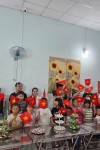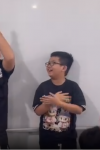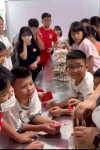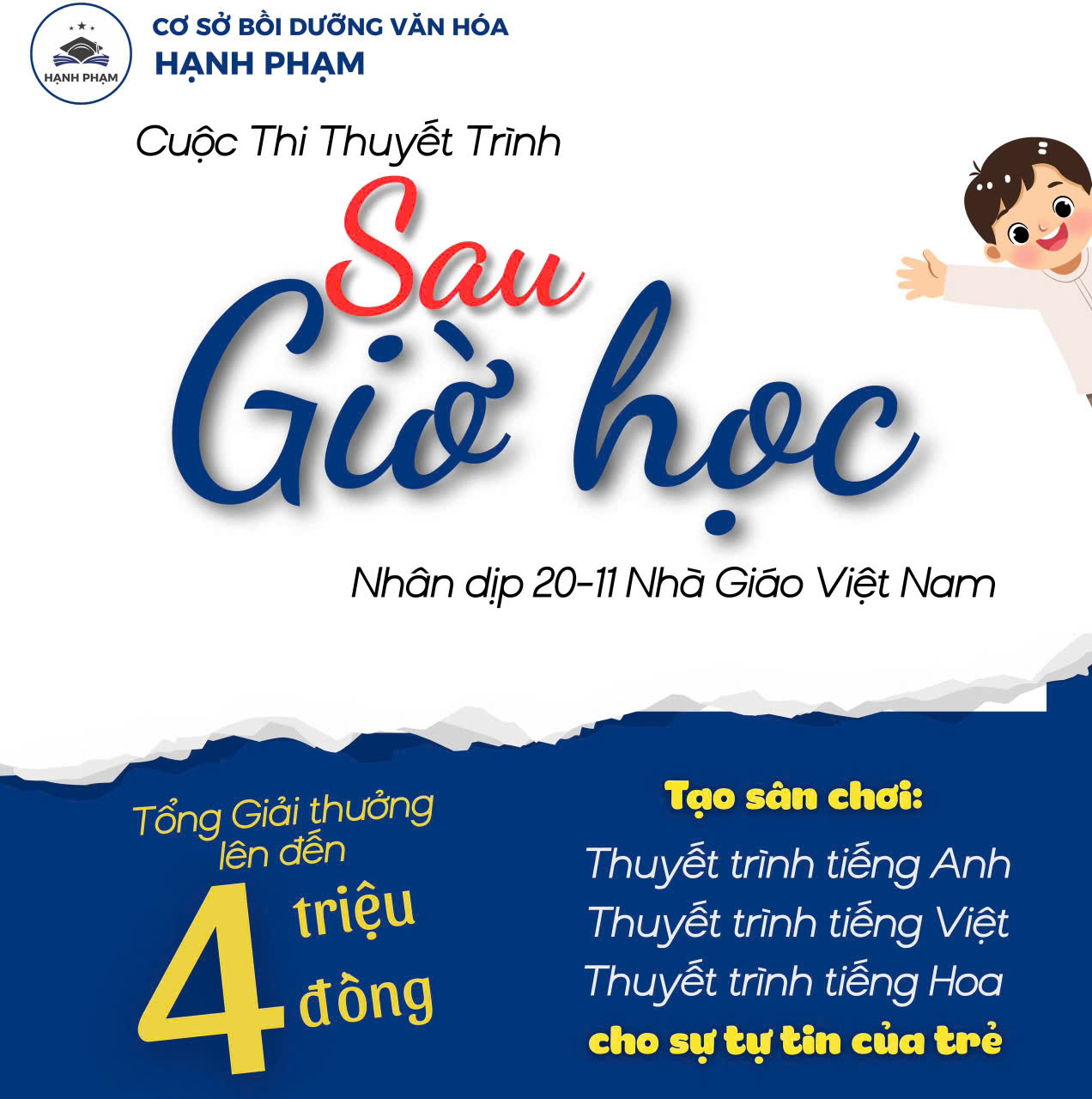Đề cương ôn tập giữa kì 1 môn Tiếng Anh 8 năm 2022 - 2023 - Trường Nguyễn Thị Minh Khai
Đề cương ôn tập giữa kì 1 Tiếng Anh 8 bao gồm các dạng bài tập tiếng Anh giữa kì 1. Thông qua đề cương ôn thi giữa kì 1 Anh 8 giúp các bạn làm quen với các dạng bài tập, nâng cao kỹ năng làm bài và rút kinh nghiệm cho bài thi giữa học kì 1 lớp 8 sắp tới. Bên cạnh đề cương giữa kì 1 tiếng Anh 8 các bạn xem thêm bộ đề thi giữa kì 1 tiếng Anh 8, đề thi giữa kì 1 Ngữ văn 8.
Sau đây là Bộ đề cương:
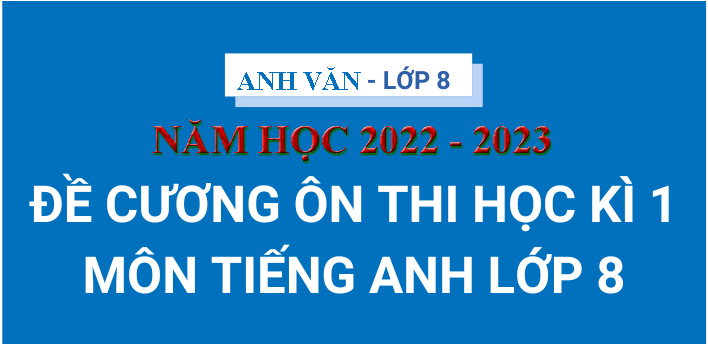
ĐỀ CƯƠNG ÔN TẬP THI HỌC KỲ I ( 2022 – 2023 )
TIẾNG ANH 8
A. VOCABULARY : Học sinh tự ôn từ unit 1 đến unit 6
B. GRAMMAR: Học sinh nắm những chủ điểm ngữ pháp sau
1. VERBS OF LIKING
VERBS OF LIKING + V-ING(GERUND) Theo sau những ĐT sau là V-ing | VERBS OF LIKING + TO INF (TO V0) Theo sau những động từ sau là to V0 | VERBS OF LIKING + V-ING/ TO V0 Theo sau những ĐT sau là V-ing / to V0 | |||
adore | mê, thích | want | muốn | like | thích |
fancy | mê, thích | would like | muốn | love | yêu |
enjoy | thích thú | would love | thích | hate | ghét |
don’t mind | không ghét lắm | learn | học | prefer | thích hơn |
detest | ghét cay ghét đắng | hope | hy vọng |
|
|
2. COMPARATIVE ADJECTIVES AND ADVERBS
* Ta sử dụng so sánh hơn để so sánh giữa hai người (hoặc hai vật).
| Comparative adjectives | Comparative adverbs |
Short | S + be + adj-er + than + Noun/ Pronoun | S + V + adv-er + than + Noun/ Pronoun |
Long | S + be + more/less + adj + than + Noun/ Pronoun | S + V + more / less + adv + than + Noun/ Pronoun |
* Một số tính từ/ trạng từ bất qui tắc:
Adjectives/ Adverbs | Comparative | Meaning |
good/well | better | Tốt hơn |
bad/badly | worse | Tệ hơn |
little | less | Ít hơn |
many/ much | more | Nhiều hơn |
far | farther/ further | Xa hơn |
* friendly | friendlier/ more friendly | Thân thiện hơn |
* Hầu hết trạng từ đều là long adverbs, ngoại trừ những trạng từ sau là short adverbs:
- late -> later, early -> earlier, fast -> faster
* Những tính từ có 2 âm tiết nhưng tận cùng là “y, ow, le, et, er” -> thì được tính là short adjective:
- happy -> happier, narrow -> narrower, quiet -> quieter, simple -> simpler, clever -> cleverer
3. ARTICLE “A/ AN/ THE”
A | AN | THE |
- Đi với danh từ đếm được số ít, chỉ 1 sự vật bất kì E.g: a costume/ a lion * a university/ a uniform/ a year | - Đi với danh từ đếm được số ít, bắt đầu là nguyên âm, chỉ 1 sự vật bất kì. E.g: an exhibtion/ an egg/ an ant * an hour, an honour | - Đi với 1 danh từ đã được đề cập trước đó. Ex: There’s a festival in my village. The festival is very old. - Đi với 1 danh từ cụ thể, riêng biệt E.g: The Kinh speak Vietnamese - Đi với so sánh nhất E.g: The Odu have the smallest population. |
4. ‘SHOULD’ AND ‘HAVE TO’
SHOULD | HAVE TO |
- Để đưa ra lời khuyên. E.g: You should respect old people. You shouldn’t sweep the floor on the first day of Tet. | - Để diễn đạt bổn phận, trách nhiệm phải làm, do yếu tố bên ngoài tác động. E.g: We have to go now because our dad is waiting for us. She has to wear that costume because it’s the family tradition. In the past, men had to wear ao dai. - Don’t have to/ doesn’t have to được sử dụng để nói việc không cần thiết phải làm. E.g: My mother doesn’t have to work on Saturdays. |
5. CONJUNCTION AND SUBORDINATOR
Conjunction/ subordinator | Meaning |
So/ Therefore | Vì vậy -> chỉ kết quả |
But, Yet/ However, Nevertheless | Nhưng, tuy nhiên -> Nối hai mệnh đề trái ngược nghĩa nhau |
Or/ Otherwise | Nếu không thì -> dùng để thêm 1 lựa chọn khác |
And/ Moreover | Và, hơn thế nữa -> để bổ sung thêm ý |
Because/ Since | Bởi vì -> chỉ nguyên nhân |
While | Trong khi -> Mệnh đề đi có ‘while’ thường dùng với thì quá khứ tiếp diễn/ hiện tại tiếp diễn |
When | Khi -> Mệnh đề đi có ‘when’ thường dùng với thì quá khứ đơn/ hiện tại đơn |
If | Nếu |
Although/ Even though/ Though | Mặc dù -> đưa ra kết quả bất ngờ |
Unless = If … not | Trừ khi |
6. PAST SIMPLE AND PAST CONTINUOUS
Past simple | Past continuous |
Positive: S + V-ed / V2 Negative: S + didn’t + V (bare-inf) Questions: Did (not)+ S + V(bare-inf)…? ̵> Yes, S +did. / No, S + didn’t. | Positive: S + was / were + V-ing Negative: S + wasn’t / weren’t + V-ing Questions: Was / Were(not) + S + V-ing …? ̵>Yes, S +was/ were. / No, S + wasn’t/ weren’t. |
Thì quá khứ thường được dùng để chỉ sự vật, hiện tượng đã xảy ra và đã kết thúc tại một thời điểm cụ thể trong quá khứ. | Thì quá khứ tiếp diễn được dùng để chỉ hành động đang xảy ra ở một thời điểm cụ thể trong quá khứ. Thì quá khứ tiếp diễn dùng để chỉ hành động đang xảy ra thì 1 hành động khác chen ngang (HĐ này chia thì QKĐ) |
E.g: Yesterday, I had English class. | E.g: At 3.30 the tortoise was running ahead of the hare. She was crying when a fairy appeared. |
EXERCISE
- PRONUNCIATION
- Choose the word whose underlined part is pronounced differently from that of the others.
- A. adore B. world C. worker D. word
- A. beach B. peach C. watch D. chemistry
- A. ritual B. regret C. float D. defeat
- A. cattle B. brave C. grassland D. nomad
- A. booked B. kicked C. wicked D. leaked
- A. thank B. ethnic C. think D. although
- A. woodcutter B. princess C. emperor D. generous
- A. ceremony B. emperor C. lantern D. incense
- A. terraced B. specialty C. heritage D. diverse
- A. heritage B. majority C. significant D. apply
- A. buffalo B. pasture C. much D. funny
- A. unity B. unique C. upwards D. music
- A. carnival B. command C. archway D. flake
- A. question B. tradition C. competition D. communication
- A. procession B. discussion C. confusion D. profession
- Choose the word which has the stress pattern different from that of the others.
- A. terraced B. unique C. gather D. costume
- A. scientific B. grammatical C. political D. historical
- A. emperor B. carnival C. invader D. scenery
- A. heritage B. tradition C. waterwheel D. ancestor
- A. legend B. Buddha C. dragon D. princess
- A. worship B. ritual C. preserve D. archway
- A. oblige B. offspring C. manner D. filmstrip
- A. filmstrip B. custom C. offspring D. prepare
- A. customer B. suitable C. amazing D. sociable
- A. procession B. generous C. woodcutter D. emperor
- A. Confusion B. magician C. important D. otherwise
- A. performance B. ceremony C. however D. procession
- A. preserve B. fortune C. ritual D. lantern
- A. reunion B. bamboo C. festival D. display
- A. participate B. politician C. communicate D. commemorate
- COMMUNICATION
I. Complete the conversationabout two options of holidays, using the phrases/ sentences (A-H) given.
A. and some bottles of mineral water B. good hotels near the beach C. a chance to watch the art kite flying festival D. but I think E. go and enjoy F. don’t forget to bring our swim costumes G. I prefer to enjoy the sea and the blue sky H. watch other sports performances on the beach |
Mai: Our class is going to hold a three-day trip. Shall we go to Da Lat Flower Festival or Nha Trang Carnival?
Nick: (1)__________________________________, so I choose Nha Trang Carnival.
Phong: I would like to go to Da Lat to see colourful flowers – flowers bloom everywhere from indoors to outside lane, across the road and the city, from the small shop to the beautiful large park.
Mai: My younger sister and I likes flowers so much, (2)_______________ Nha Trang Carnival is much more exciting with a lot of cultural and recreational events.
Nick: I want to swim and (3)___________________. It sounds great!
Phong: Are there any other activities in Nha Trang?
Mai: I know your hobby is flying a kite, so in Nha Trang you have (4)______________________
Phong: Really! Awesome. Let’s (5)_______________ Nha Trang Carnival this year. Right?
Nick: Yeah. I think we should take some canned food (6)______________________.
Phong: And (7)______________. Remember to bring the sun lotion for your younger sister and you, Mai.
Mai: Thanks, Phong. We should book our trip in advance, so we can stay at (8)________________.
Phong: We’ll talk about this to our class in the next meeting.
Nick: That’s right! Maybe our classmates have more interesting ideas.
Mai: And our teacher will tell our parents about the plans for the trip to Nha Trang.
II.Complete the dialogue with the appropriate phrases or sentences (A - H).
A. What should I do at the dinner table? B. Try to finish everything on your plate. C. and do not sit down until the oldest member has seated. D. Do you mind if I ask you something E. place your chopsticks, fork or knife on your bowl or plate. F. You can ask whatever you want. G. Do I have to wear formal clothes? H. What should I do when I’m invited to a Vietnamese house for a meal? |
Maria:Hi, Mai! I’m going to take a trip to Vietnam next month.(9) about Vietnamese customs and etiquette?
Mai:Not at all. (10)
Marla:(11)
Mai:You should bring a small gift, such as flowers, fruits or sweets wrapped in colourful paper.
Maria:What should I wear? (12)
Mai:No. Just dress conservatively.
Maria:(13)
Mai:Wait to be shown where to sit (14)
Maria:What else?
Mai:(15) Leaving food on your plate is considered impolite... When you have finished eating, (16)
Maria:Thanks for all.
- VOCABULARY AND GRAMMAR
- Choose the best answer A, B, C, or D.
- My dad doesn’t mind…………… my mom from work every day.
A. pick up B. picked up C. picking up D. picks up
- Nam doesn’t like ………………. Soccer every day.
A. play B. plays C. playing D. played
- Does she fancy …………… a book to the younger children?
A. reads B. reading C. to read D. read
- My parents enjoy …………… on Sundays.
A. garden B. gardening C. gardened D. gardens
- They love ……………with their friends.
A. eat out B. ate out C. having eaten D. to eat out
- I prefer …………… people.
A. text B. to text C. texted D. texts
- My father detests …………. soccer in the morning
A. playing B. doing C. going D. seeing
- The farmer rides the buffalo -____________ carts loaded full of rice home.
A. drawn B. drawing C. drew D. draw
- Using computers too much may have harmful effects ________ your minds and bodies.
A. on B. to C. with D. onto
- People in the countryside live ___________ than those in the city.
A. happier B. happily C. happy D. more happily
- I love the people in my village. They are so ________ and hospitable.
A. friendly B. vast C. slow D. inconvenient
- We help load the rice _________ carts on the first day of our trip to the countryside.
A. in B. onto C. by D. on
- I’ve been kind of _____________ to the net.
A. addict B. addictive C. addicted D. to addict
- My father sometimes goes ________in the forests. He’d like to find some more food for our family.
A. hunt B. hunting C. to hunt D. hunted
- Look! Some children are ____________the buffaloes.
A. picking B. playing C. driving D. herding
- The sky is _______here in the countryside because there are no buildings to block the view.
A. tidy B. close C. dense D. vast
- Is living in the city _________ than living in the country?
A. more convenient B. as convenient C. most convenient D. so convenient
- He is surprised __________that there are 54 ethnic groups in our country.
A. to understand B. to study C. to know D. find
- The Viet (or Kinh) have______ number of people, account for about 86% of the population.
A. large B. the large C. larger D. the largest
- ________ ethnic group has a larger population, the Tay or the Ede?
A. What B. Which C. Why D. Who
- Teenagers enjoy listening to music and____________ out with friends.
A. hang B. to hang C. hanging D. hangs
- YMoan was the greatest pop singer of the ____________ group in Dak Lak Province.
A. Tay ethnic B. Thai ethnic C. Ede ethnic D. Muong
- ____________ month is the Hoa Ban Festival of the Thai people held in?
A. Which B. When C. How many D. However
- Life in a small town is ____________ than that in a big city.
A. less peaceful B. much more peaceful C. much peaceful D. peaceful
- Viet Nam is …………. Multicultural country with 54 ethnic groups.
A. a B. an C. the D. A and C
- The Lao are one of ……………… Thai- speaking peoples.
A. a B. an C. the D. A and C
- My parents decide ………………….. Hanoi next summer vacation.
A. Visit B. to visit C. visited D. visiting
- Terraced rice fields in Sa Pa are slopes claimed for cultivation in hilly or ……………areas.
A. mountainous B. mountain C. highland D. grassland
- Vietnam is a country with tremendous …………………… with 54 ethnic groups.
A. diverse B. diversely C. diversity D. diversify
- I’ve got my key. I found it while I ................. for the others.
A. looked B. have looked C. looking D. was looking
- This filmstrip __________ the daily routines of a typical Vietnamese family.
A. reflects B. accepts C. obliges D. sprays
- Some Vietnamese schools make students wear Ao Dai, the __________ dress of Vietnam.
A. tradition B. traditional C. traditions D. traditionally
- Our customs are passed __________ from generations to generations.
A. over B. up C. to D. down
- Can you tell me what is the difference __________ custom and tradition?
A. in B. of C. among D. between
- Before beginning the meal, we should __________ for the oldest person to start.
A. wait B. to wait C. waiting D. waited
- You don’t have __________ tips for the waiters in Vietnam.
A. leave B. leaving C. to leave D. left
- My mother taught me some table __________ when I was young.
A. manners B. unities C. prongs D. offsprings
- Although I have never been to the place, it has a __________ of belonging to me.
A. prong B. palm C. course D. sense
- My teacher paid me a __________ because I finished all difficult tasks.
A. cutlery B. manner C. offspring D. compliment
- It’s a custom in the USA as people use __________ in all meals.
A. cutleries B. offsprings C. belongings D. tips
- Vietnam is trying __________ traditional Quan Ho singing.
A. preserve B. to preserve C. preserving D. preserved
- There are a lot of __________ at Mid-Autumn Festival.
A. lanterns B. offerings C. worships D. archways
- Ly Thuong Kiet is worshiped in this temple for his success in defeating the __________.
A. invaders B. emperors C. processions D. incenses
- We like Flower Festival in Da Lat __________ it’s joyful.
A. although B. however C. because D. therefore
- Hung King Temple is the place where all Hung Emperors are__________.
A. worship B. to worship C. worshipping D. worshipped
- My mom often go to Vong village to buy me some rice __________.
A. incense B. ritual C. flake D. float
- Have you ever participated __________ a carnival?
A. to B. with C. for D. in
- Last year, we saw a colorful __________ with a lot of offerings in Thanh Giong Festival.
A. procession B. gong C. anniversary D. lake
- You should listen to __________ court music when going on a cruise in Huong river.
A. national B. royal C. principal D. animal
- The most exciting part of Lim festival __________ Quan Ho singing.
A. are B. is C. be D. am
- My grandmother often told __________ to me when I was young.
A. fairy tales B. court music C. wolf pack D. ogre man
- The fox in the fable “The fox and the grape” is very __________.
A. brave B. generous C. cunning D. giant
- Have you ever seen a very huge person, or a __________?
A. tale B. evil C. giant D. glitch
- In the story, the princess was walking in the campus of the cattle when an eagle __________.
A. appear B. appeared C. was appearing D. appearing
- There is a __________ that this temple has an ogre.
A. evil B. Buddha C. emperor D. legend
- At 7 p.m. yesterday, the lion __________ its meal in the zoo
A. is having B. was having C. had D. has
- The witch was so __________ that the two kids felt afraid.
A. cruel B. nice C. kind D. generous
- I __________ of meeting a prince last night.
A. dreaming B. dream C. dreamt D. to dream
- The princess __________ by a brave knight after five days.
A. was rescued B. rescue C. rescued D. rescuing
- What was the end __________ the story?
A. on B. of C. to D. at
- READING
- Read the following passage, and answer the questions below WITH NO MORE THAN FIVE WORDS.
Duong Lam: An ancient Vietnamese village
Duong Lam Village is located in Duong Lam Commune at a 45 km distance from Ha Noi. It is the birthplace of two kings in the history of Vietnam, Phung Hung (or Bo Cai Dai Vuong) and Ngo Quyen, who opened up the long-term self-control and independence period of Vietnam after Bach Dang Victory in the year 938. All houses, gates, village gates and wells are built of laterite creating an architectural complex, a unique village that is typical for villages in the midlands in the North of Vietnam.
At present, there are still nearly old 200 houses and many other historical monuments such as Phung Hung Temple, Ngo Quyen Royal Tomb, Mong Phu Communal House, Ho Gam Hill at which Phung Hung killed tigers to secure villagers and the temple at which the diplomat Giang Van Minh is worshiped.
1. Where is Duong Lam Village?
________________________________________________________________
2. Who were the two kings whose birthplace is Duong Lam Village?
________________________________________________________________
3. What are all houses, gates, village gates and wells made of?
________________________________________________________________
4. How many old houses are there in Duong Lam?
________________________________________________________________
5. Where did Bo Cai Dai Vuong kill tigers?
________________________________________________________________
- Read the passage. Choose the letter A, B, C or D to complete the passage below
Little Red Riding Hood
Once upon a time, there was sweet little girl. Everyone called her Little Red Riding Hood, (1)_________ she always wore a red riding hood which her grandmother made for her.
One day Little Red Riding Hood’s mother said, “Here, child, take this basket to your grandmother. It’s got bread, butter, cake and berries in it. Your grandma’s feeling sick and I hope this (2)_________ her feel better. Don’t talk to strangers, don’t leave the path and walk straight to your grandma’s house.”
Little Red Riding Hood’s grandmother lived half (3)_________ hour away in the woods outside the village. So Little Red Riding Hood set off. The girl had just entered the woods, when a wolf (4)_________ out of the trees. She wasn’t scared because she didn’t know wolves are dangerous.
They walked together for a while. Then the wolf said: “What lovely flowers there are here! Why don’t you (5)_________ some for your grandma?” The girl looked around and saw all those beautiful flowers. She thought that her grandmother would be delighted to have some fresh flowers and, despite her mother’s advice, she left the path.
- A. although B. because C. therefore D. however
- A. make B. made C. to make D. will make
- A. an B. a C. x D. the
- A. come B. coming C. came D. to come
- A. pick B. picked C. picking D. pick
- Read the following passage, and answer the questions below with no more than THREE WORDS
Nha Trang Carnival – Exciting Times in June!
Join the opening ceremony – an impressive show giving the history of Nha Trang, a city with a good climate provided by nature. Then comes the firework display, which lights up the whole city, followed by the street carnival the next morning. You will also like various traditional, musical performances by the Viet, the Cham, and other ethnic peoples, in addition to performances of songs about the sea. The following day brings the excitement of sea swimming, yachting, boating, and wind-surfing events. When the night falls, the public dances begin – you are welcome to join in! Don’t miss this colorful mix of cultures!
- What is showed in the opening ceremony?
……………………………………………………………
- What is showed after the opening ceremony?
……………………………………………………………
- When is street carnival held?
……………………………………………………………
- Are there any music performances?
……………………………………………………………
- What can we do when the night falls?
……………………………………………………………
- Read the following passage, and choose the letter A, B, C or D
HOW TO USE NAPKINS IN AN AMERICAN RESTAURANT?
As soon as you are seated, remove the napkin from your place setting, unfold it, and put it in your lap. Do not shake it open. At some very formal restaurants, the waiter may do this for the diners, but it is not inappropriate to place your own napkin in your lap, even when this is the case. The napkin rests on the lap till the end of the meal. Do not clean the cutlery or wipe your face with the napkin. NEVER use it to wipe your nose!
If you excuse yourself from the table, loosely fold the napkin and place it to the left or right of your plate. Do not refold your napkin under it. Never place your napkin on your chair. At the end of the meal, leave the napkin semi-folded at the left side of the place setting. It should not be crumpled or twisted; nor should it be folded. The napkin must also not be left on the chair.
- As soon as you are seated, remove the napkin from your place setting, unfold it, and put it in your __________.
A. lap B. knees C. chest D. head
- Does the napkin rest on the lap till the end of the meal?
A. Yes, it is B. No, it doesn’t C. Yes, it does D. No, it isn’t
- What shouldn’t we do with the napkin?
A. clean the cutlery B. wipe your face C. wipe your nose D. All answers above
- What does the word "it" in line 7 refer to ?
A. meal B. plate C. napkin D. chair
- If you excuse yourself from the table, should you loosely fold the napkin?
A. Yes, I do B. Yes, we should C. No, I don’t D. No, we shouldn’t
- The napkin _________ be left on the chair.
A. mustn’t B. can’t C. needn’t D. haven’t
- Read the paragraph then fill the blank with the words in the box.
ancient perform ethnic commemorates performances respect procession ritual |
The Kate Festival is held by the Cham (22)___________ group in Ninh Thuan in the central part of Viet Nam. This festival (23)____________ the heroes - God Po Klong Garai and Po Rome and shows their (24)____________ to these gods.
At the festival, the Cham people have to do a (25)____________ to welcome the costumes from the Raglai – the (26)____________ Cham. People take part in a (27)____________ to the nearby temple. When the procession arrives at the Cham tower, a group of dancers (28)____________a welcome dance in front of the tower. Besides, there is the Pob Bang (door opening) by a magician in the temple and the chanting of a hymn. This is a really joyful festival which features many other activities like (29)____________ of the Ginang drum and then Saranai flute and Apsara dance.
- WRITING
- Rewrite the second sentence so that it has a similar meaning to the first one.
- My house is smaller than your house. (BIGGER)
-> Your house .……….……….……….……….……….………………………
- I like to listen to music. (FANCY)
-> I …………….……….……….……….……….……….………….……….
- The black dress is more expensive than the white one. (CHEAPER)
-> The white dress ….……….……….……….……….……….………….……….
- We don’t use oil lamps any more. (TO)
-> We ……….……….……….…………….……….……….……….……….
- I adore listening to music every day. (ENJOY)
-> I …………….……….…….……….……….……….…………………….….……….
- The red car is more expensive than the black one. (LESS)
-> The black car ….……….……….……….……….……….……………………….……….
- It’s interesting to hang out with friends (FIND)
-> I ….……….……….……….……….……….……………………….
- I find it boring to watch Tiktok. (IS)
-> It ………………………………………………………………………………
- Children are not allowed to leave the table without asking for permisson (SHOULD)
-> Children …………………………………………………………
- Students shouldn’t bring smartphones to school. (ALLOWED)
-> Students …………………………………………………………
- You are not allowed to wear your hat when going inside the main worship area. (HAVE TO)
-> You ….……….……….……….……….……….……………………….……….
- The theater has 1000 seats. (ARE)
-> There …………………………………………………………
- I will never read this book again. (LAST)
-> This …………………………………………………………
- This is the first time I have tried Sashimi. (NEVER)
-> I ….……….……….……….……….……….……………………….……….
- Lang Lieu was very poor; therefore, he couldn’t buy any special food . (BECAUSE)
-> …………………………………………………………………………………………..…..…
- During Tet, Vietnamese people buy all kinds of sweets, and they make Chung cakes as well. (MOREOVER)
-> …………………………………………………………………………………………..…..…
- The Hung King Temple Festival was a local festival, but it has become a public holiday in Viet Nam since 2007. (HOWEVER)
-> …………………………………………………………………………………………..…..…
- The Mongols invaders were powerful. However, Tran Quoc Tuan defeated them three times in the 13th century. (ALTHOUGH)
-> ………………………………………………………………………………………….…..…..
- If we pass the driving test, we can have the driving license. (UNLESS)
-> …………………………………………………………………………………………..…..…
- Unless there is a traffic jam, I will return home earlier. (IF)
-> …………………………………………………………………………………………..…..…
- Write a short paragraph (80 - 100 words)
- Write a paragraph about your favourite leisure activity.
You should write:
- What is it?
- How long have you taken up this hobby?
- What are the benefits?
- Write a short paragraph about changes in your village / town / countryside.
You should write:
- How do people travel?
- How were schools in the past?
- How did children use to entertain themselves?
- Write a short paragraph about traditional festival in Viet Nam
You should write:
- What festival it is.
- When and where the festival take place
- What activities people do in the festival.
- How you feel about the festival
Ý kiến bạn đọc
Những tin mới hơn
Những tin cũ hơn
 Công bố lịch thi tốt nghiệp THPT 2024, diễn ra ngày 26-28/6
Công bố lịch thi tốt nghiệp THPT 2024, diễn ra ngày 26-28/6- Bộ GD-ĐT công bố đề tham khảo thi tốt nghiệp THPT năm 2024
 Học sinh Bình Dương sẽ tựu trường từ ngày 28-8
Học sinh Bình Dương sẽ tựu trường từ ngày 28-8 Danh mục Sách giáo khoa được sử dụng trong năm học 2023 - 2024 trên địa bàn tỉnh Bình Dương.
Danh mục Sách giáo khoa được sử dụng trong năm học 2023 - 2024 trên địa bàn tỉnh Bình Dương. Bình Dương: Hướng dẫn tổ chức tuyển sinh lớp 6 THCS và lớp 10 THPT năm học 2023 - 2024
Bình Dương: Hướng dẫn tổ chức tuyển sinh lớp 6 THCS và lớp 10 THPT năm học 2023 - 2024
- Tài liệu ôn tập Tiếng... - 23/06/2025
- 250 bài toán chọn lọc... - 25/05/2025
- Sách ôn tập học kỳ 1... - 19/05/2025
- Chuyên đề hình có trục... - 10/05/2025
- Chuyên đề Toán 6 - Hình... - 10/05/2025



